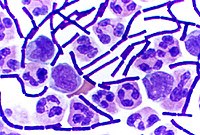
Photo from wikipedia
An important question for bacterial cell division is how the invaginating septum can overcome the turgor force generated by the high osmolarity of the cytoplasm. I suggest that it may… Click to show full abstract
An important question for bacterial cell division is how the invaginating septum can overcome the turgor force generated by the high osmolarity of the cytoplasm. I suggest that it may not need to. Several studies in Gram‐negative bacteria have shown that the periplasm is isoosmolar with the cytoplasm. Indirect evidence suggests that this is also true for Gram‐positive bacteria. In this case the invagination of the septum takes place within the uniformly high osmotic pressure environment, and does not have to fight turgor pressure. A related question is how the V‐shaped constriction of Gram‐negative bacteria relates to the plate‐like septum of Gram‐positive bacteria. I collected evidence that Gram‐negative bacteria have a latent capability of forming plate‐like septa, and present a model in which septal division is the basic mechanism in both Gram‐positive and Gram‐negative bacteria.
Journal Title: BioEssays
Year Published: 2017
Link to full text (if available)
Share on Social Media: Sign Up to like & get
recommendations!